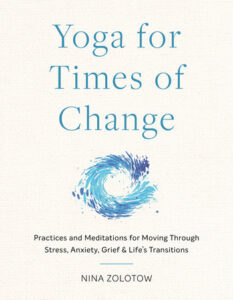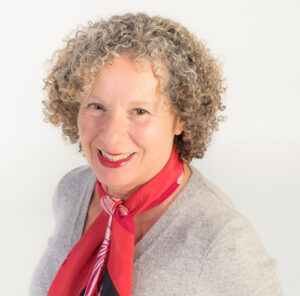 I met Nina Zolotow several years ago at the Symposium on Yoga Therapy and Research and I worked with her when I was a contributor for the Yoga for Healthy Aging blog, for which she is Editor-in-Chief.
I met Nina Zolotow several years ago at the Symposium on Yoga Therapy and Research and I worked with her when I was a contributor for the Yoga for Healthy Aging blog, for which she is Editor-in-Chief.
Her first book, Yoga for Healthy Aging, co-authored with Baxter Bell, was published in 2017, and is still a wonderful book I recommend today.
I was happy to learn that she has just authored another book, Yoga for Times of Change: Practices and Meditations for Moving Through Stress, Anxiety, Grief and Life’s Transitions. I wanted to learn more about it, support Nina’s good work, and share it with you all, in hopes it helps you in some way:
Shelly: What inspired you to write a book specifically on these topics of stress, anxiety, grief and life’s transitions?
Nina: I’m glad you asked that question! Because, actually, the subtitle for the book—which was chosen by the publisher—doesn’t cover everything that’s in the book.
In general, the book is about adapting to and accepting change, whether those changes are personal, such as getting a divorce or moving to a new community, or societal, such as political changes, environmental changes, and, of course, living through a pandemic.
So, in addition to stress, anxiety, and grief, the book covers other challenging emotions we experience in response to change, including anger and depression.
It also covers how you can use yoga to adapt to physical changes you experience, both temporary illnesses and injuries as well as more permanent changes.
Finally, the last part of the book describes how to use yoga to cultivate equanimity in our ever-changing material world, including how to be present and more content in your life as it is and to learn to accept impermanence as natural part of life, rather than something to struggle against.
I was inspired to write this book because I realized that the reason I’ve been so committed to yoga all these years was due to how much it has helped me weather the ups and downs of life with a measure of equanimity.
Many years ago I actually had a breakdown—something I describe in detail in the book’s preface. It was the result of feeling overwhelmed by changes in my life I was currently experiencing and feeling anxious about future changes that were looming. Although I did some yoga at the time, I didn’t have the knowledge or skill to choose the right poses and practices for my particular condition. When I later learned more specifically about how yoga can help with stress and anxiety, it literally changed my life, and I vowed then that I would share what I’d learned with as many people as possible.
Of course, I have shared a lot about it through teaching and through my blog Yoga for Healthy Aging. But in 2019 when my editor at Shambhala, Beth Frankl asked if I wanted to write a book about yoga by myself, I realized that this was the perfect opportunity to share in one place everything I’d learned in the last 20 years about how yoga can help you adapt to and accept change.
In 2019, when I agreed to write a book about adapting to and accepting change, there was no sign yet of the coronavirus pandemic that soon would affect all our lives, worldwide. But as I wrote the book during 2020 and part of 2021, the pandemic we were experiencing combined with environmental changes—we had an extreme fire season in my area—as well as political ones and societal ones had profound effects on my thinking about how change can affect our lives.
So, the experiences of many different people during that time also inspired my writing.
Shelly: What informs your writing in this book?
Nina: I’m the kind of person who always wants to know why and how as well as what. For everything I learned from my yoga teachers about how yoga can help us weather the ups and downs of life, such as inverted poses being “calming” and backbends being helpful for depression, I want to know why. So, I always combine my understanding of yoga with whatever science is out there to support the claims that yoga teachers make and also, lately, with some information about human evolution and psychology. I feel one of my strengths is my ability to explain both yoga and scientific concepts in simple, accessible terms, so I share the science with my readers.
And although my personal practice definitely informs my work, I also know that everyone is different and what works for one person might not work for another. So, I offer a wide range of options for my readers, including practices that work for me and practices that don’t work for me but that do work for others.
I also include stories and examples from students and friends who have used yoga in very different ways that I have.
An example is I write about the potential benefits of restorative yoga—even though, personally, that’s not my own go-to practice when I’m feeling stressed—trust me, I’ve tried it many times and it doesn’t work well for me—because I know many people who love this practice during stressful times.
I’m also inspired by stories I’ve heard from people I know who do yoga from different traditions than the one I have experience with (Iyengar-style yoga).
Shelly: What do you mean by, or how would you describe, a “life transition” and in what way(s) might yoga help with a life transition?
Nina: A “life transition” is actually the publisher’s term but I think it encompasses the kinds of ordinary changes we might experience as we move through our lives, such as getting married or divorced, having children, losing people we love, changing jobs, moving to a new community, becoming ill or having a physical injury, and so on. All these transitions, even the ones that we see as “positive,” cause some amount of stress. For example, I remember feeling very nervous the day I got married, even though it was something I was happy about. But many transitions can very challenging, and for some people may cause anxiety, anger, depression, or grief.
Yoga can help you weather life’s transitions by reducing your stress levels in general, which makes you both more comfortable and more resilient. And for times when you experience anxiety, anger, depression, and grief, yoga can help reduce your suffering, allowing you to see more clearly, and offers tools for resolving some of your difficulties.
Most importantly I think yoga helps you to start to think differently about life in the material world, leading you to accept the reality of impermanence rather than fighting against it, which is one of the things that causes suffering.
Shelly: How is the book structured and what can we expect to get from it?
Nina: The book contains a combination of background information (because I think knowing how and why things work can help you make informed decisions about what to practice) and simple, accessible practices that you can choose from.
And because I thought people will want to start practicing right away, I don’t have a “background” section and then a “practice” section. Instead, I include specific practices, poses, and sequences in every single chapter except the introduction.
That way, if people don’t want to read the entire book, they can just go to the chapter that’s currently relevant for them and find both the background and practices there.
For example, if you are suffering from anxiety, you can go to that part of the book and find background information about anxiety as well as different practices to try along with references to other parts of the book that may be relevant for you.
Shelly: What kind of practices do you include and when might they be useful to use in someone’s life?
Nina: Although I have a number of asana practices that are targeted to certain conditions (anger, anxiety, depression, and grief), the second chapter of the book has several different “coping” tools that readers can choose from. They are very simple practices—many are just one pose—and they are designed to be accessible for different levels of ability and yoga experience. I also have three different simple, accessible mini sequences for reducing stress levels when you’re feeling particularly stressed. All of these can be helpful for everyone.
I also have quite a number of meditations people can choose from, depending on what their goals are or what effects they are looking for. (Although people often think all meditation is equivalent, different types do have different effects and I explain why in my chapter on pranayama and meditation.)
An example I think everyone might find useful at some point in their lives is the love meditation in the grief chapter. It allows you to meditate on someone you have lost by focusing on your love for them or simply to wish peace for someone who is dying.
Shelly: Anything else you’d like to share?
Nina: I just want to thank you, Shelly, for interviewing me for your blog and for supporting my work. My main goal in writing this book was to simply share with others the many things I’ve learned about how yoga can reduce suffering in the hopes it will help as many people as possible. So having you support me in that effort is invaluable.
The book will be available on May 24, 2022.
It’s available for preordering HERE!
Shelly: Can’t wait to get my copy!
 Nina Zolotow, RYT500, MFA, is Editor in Chief of the Yoga for Healthy Aging blog as well as a contributing writer, and is the author of the forthcoming book Yoga for Times of Change, which will be published in Spring 2022 by Shambhala Publications. She is a long-time yoga writer as well as a long-time yoga practitioner and a certified yoga teacher. Her special areas of expertise are yoga for emotional well-being (including yoga for stress, insomnia, depression, and anxiety) and yoga for healthy aging.
Nina Zolotow, RYT500, MFA, is Editor in Chief of the Yoga for Healthy Aging blog as well as a contributing writer, and is the author of the forthcoming book Yoga for Times of Change, which will be published in Spring 2022 by Shambhala Publications. She is a long-time yoga writer as well as a long-time yoga practitioner and a certified yoga teacher. Her special areas of expertise are yoga for emotional well-being (including yoga for stress, insomnia, depression, and anxiety) and yoga for healthy aging.




